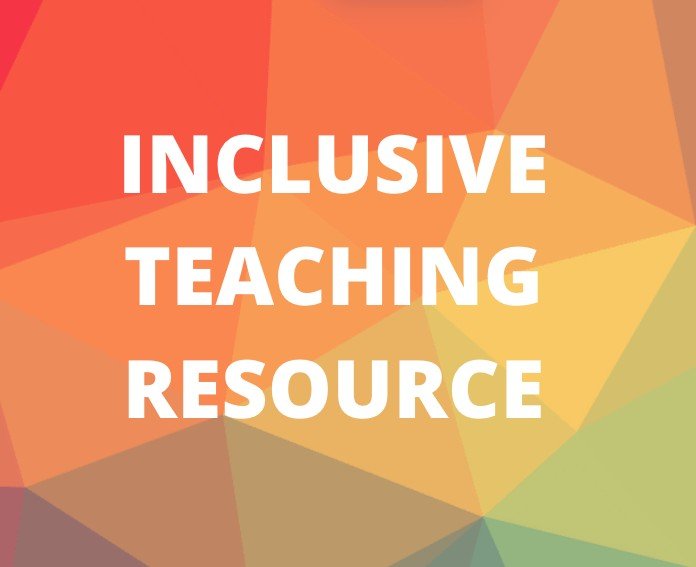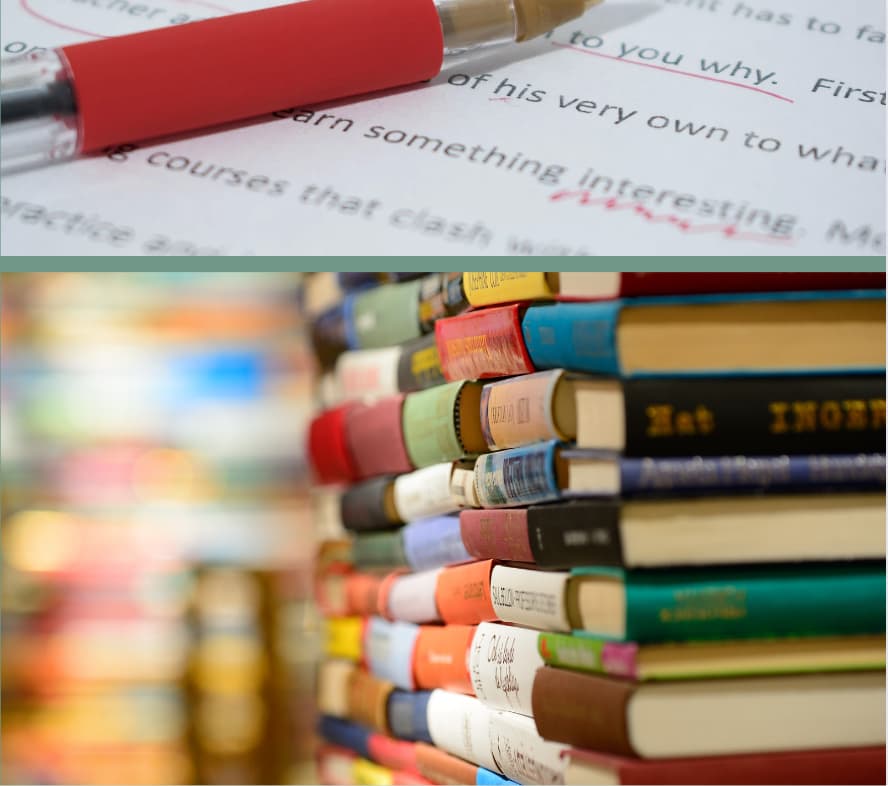resources
resources
Resources
About
Below you'll find a curated list of resources from all five sections of the Inclusive Teaching Resource. You can use the links below to jump to a particular section's resources:
Instructional Content
Resources:
-
“Spotlighting Diverse Experts in STEM” (Curated list)
-
Coalition for Diversity and Inclusion in Scholarly Communications, Joint Statement of Principles (webpage)
-
Inclusive Citation, Andrea Baer, Rowan University Libraries (Library Research Guide)
-
TILT Higher Ed Examples and Resources, Transparency in Learning and Teaching Project (Website)
-
The UDL Guidelines,Center for Applied Special Technology (Website)
-
Higher Education Accessibility Online Resource Center, National Federation for the Blind (Website)
Accessible PDFs -
Screen Readers, American Foundation for the Blind (Website)
-
The Essential Higher Ed Closed Captioning Guide, Kevin Erler (PDF)
-
Instructional Accessibility Tips – Inclusive Teaching, University of Michigan (Blog)
-
Are PDFs Accessible? University of Washington DO IT Center (Blog)
-
Create an Affordably-Minded Class, Rowan University Student Success Programs (Website)
-
An Introduction to Content Warnings and Trigger Warnings, Inclusive Teaching, University of Michigan (Website)
-
5 Steps to Take as an Antiracist Data Scientist, Emily Hadley (Web article)
Teaching Practices
Resources:
-
“An Activity That Promotes Engagement with Required Readings, Even in Large Classes,” Ashley Harvey, Faculty Focus (Article)
-
“Increasing student motivation and participation,” Cornell University, Cornell University, Center for Teaching Innovation (Article)
-
15 Active Learning Activities to energize your next college class, Tricia Wenham (Article)
-
Using Multiple Assessment Methods to Explore Student Learning and Development Inside and Outside of the Classroom, Peggy Maki (Article)
-
Calling on Students in Equitable Ways, Instructional Moves, Harvard University Graduate College of Education (Website)
-
The Funds of Knowledge Approach, Funds of Knowledge Alliance (Web page)
-
Exploring Cultural Concepts: Funds of Knowledge, National Center on Cultural and Linguistic Responsibility (PDF handout)
-
An Overview of Community Cultural Wealth: Toward a Protective Factor Against Racism. Nancy Acevedo and Daniel G. Solorzano. Urban Education (Journal article) https://doi.org/10.1177/00420859211016531
-
Funds of Knowledge: Theorizing Practices in Households, Communities, and Classrooms. Cathy Amanti, Norma Gonzalez, and Luis C. Moll, eds. (Book)
-
Differentiated Instruction, in Educational Psychology, Nicole Arduini-Van Hoose
-
Accessibility Concerns in Laboratories, Allison Kelly (Infographic)
Culture of the Community
Resources:
-
Territory Acknowledgement, Allison Jones, Native Land Digital (Website)
-
Rowan Land Acknowledgement, Rowan University (Website)
-
Notes for Inclusive Syllabi: Diversity and Land Acknowledgement Statements: Guides & Tips (Boston University, Teaching Writing)
-
Native American Studies Research Guide (Campbell Library, Rowan University). Includes a page of Research and Writing Resources.
-
Supporting Transgender Students, Sherry Zane, Faculty Focus (Web article)
-
A Guide to Incorporating Social-Emotional Learning in the College Classroom: Busting Anxiety, Boosting Ability, Kristel M. Gallagher, Ph.D. Shevaun L. Stocker, Ph.D, Society for the Teaching of Psychology (PDF)
-
Mid-Semester Focus, Rowan Faculty Center for Excellence in Teaching and Learning (Website)
-
21 Quick Questions to Check In on Your Students’ Well-Being in 2023-24, Panorama Education (Web article)
-
Asset Mapping for Equitable Team Work, Kaitlin Mallouk, Spring 2022 Rowan Teaching Connection GIFTS Conference (slides)
-
Developing a Growth Mindset with Carol Dweck, Carol Dweck (Video)
-
Goal Setting Practices that Support a Learning Culture, Kappan (Web article)
-
25 Best SMART Goals for Students, Brandon Gaille Small Business & Marketing Advice (Webpage)
-
Three Mindset Shifts that Can Help Students Succeed, Greater Good Magazine, UC Berkeley (Web article)
-
“OGI Community Agreements” NYU (List)
-
“Microaggressions in the Classroom” Dr. Yoland Flores Niemann (Video)
-
“Microaggressions in the Classroom” Portman, Bui, Ogaz, Trevino (PDF)
-
“Addressing Microaggressions in the Classroom” University of Washington (Website)
-
Current Events in Your Classroom, Facing History (Instruction resources)
-
Leveraging the Neuroscience of Now, Mays Imad, Inside Higher Ed (Article)
-
Hand, Heart, Conscience, Facing History & Ourselves (Webpage)
-
Creating a Positive Classroom Climate for Diversity, Juan C. Garibay, UCLA Diversity & Faculty Development (PDF)
-
“Implicit Association Test”, Harvard University (Quiz)
-
A Primer on Pronouns, ASEE (PDF)
-
Create an Affordability Minded Class!, Rowan University Affordability Task Force (Web page)
-
“Online Literacy Instruction Principles and Tenets,” Global Society of Online Literacy Educators (Web)
-
“A Guide to Developing an Accessible Course” Developed by Juliana Rausch, Kristine Lafferty, Leslie Allison, Jade Jones, Celeste Del Russo, and Amy Woodworth in Rowan’s Writing Arts Department (Google Doc, must login with Rowan credentials)
-
“Inclusive Teaching and Learning Online,” Columbia University for Teaching and Learning
Policy
Resources:
-
Policy Review Questions, Jeff Bonfield (Document)
-
Strict Attendance Policies Adversely Impact Students, Sarah Bond, The Daily Illini (Article)
-
Time to Make Your Mandatory Attendance Optional?, Joe Gerald and Benjamin Brady, Chronicle of Higher Education (Article) (access via Rowan Libraries)
-
Proctoring Software, Mozilla (Video)
-
Bias in Plagiarism Accusations, Tiffany Martínez (Blog)
-
Faculty Information on Academic Integrity at Rowan, Rowan Academic Affairs (Website)
-
10 Principles for Student Data Privacy and Equity, Student Privacy Compass (Article)
-
Data Privacy in Higher Education: Yes, Students Care, Educause Review (Web article)
-
5 Reasons to Let Students Keep their Cameras Off During Zoom Classes, The Conversation (Web article)
-
Invisible Disabilities and Postsecondary Education, Disabilities, Opportunities, Internetworking, and Technology, University of Washington (Web page)
-
College Students with “Hidden” Disabilities, Higher Education Research Institute, UCLA (Research brief)
-
Enhancing Engagement of Students with Invisible Disabilities: Rowan University Faculty Knowledge and Awareness and Student Perspectives, Shariese Abdullah (Dissertation on study of Rowan University)
-
“Teaching the Hidden Curriculum Inclusive Teaching Guides & Tips,” Boston University (Web)
-
Rowan Recommended Syllabus Statements, linked to from the Rowan Faculty Center for Excellence in Teaching and Learning (Document)
Assessment
Resources:
-
TILT Higher Ed Examples and Resources, Transparency in Learning and Teaching Project) (Website)
-
Checklist for Designing Transparent Assignments, TILT Higher Ed (PDF)
-
Revised Bloom’s Taxonomy Assignment Cues, TILT Higher Ed (PDF)
-
Why Should Assessments, Learning Objectives, and Instructional Strategies Be Aligned?, Carnegie Mellon University, Eberly Center - Teaching Excellence & Educational Innovation (webpage)
-
What Is the Difference between Formative and Summative Assessment, Eberly Center, Carnegie Mellon University
-
Instructional Scaffolding to Improve Learning, Center for Innovative Teaching and Learning, Northern Illinois University (Web page)
-
Scaffolding and Sequencing Writing Assignments, The Writing Center, University of Colorado-Denver, Anschutz Medical Campus (PDF)
-
Sequencing and Scaffolding Assignments, Sweetland Center for Writing, University of Michigan (Web page)
-
Teaching More By Grading Less (or Differently), Jeffrey Schinske and Kimberly Tanner, CBE Life Sciences Education (Article)
-
A Contract for a Final Grade of B in First Year Writing, Peter Elbow (PDF)
-
Contract Grading Reading and Resources, Whitney Cox (Curated list)
-
The Case Against Zeros in Grading, Alexis Tamony, Edutopia
-
Setting Automatic Grades for Missing Assignments in Canvas, Champlain College Center for Learning & Teaching
-
Teaching: Is It Time to Redefine Class Participation? Beth McMurtrie, Chronicle of Higher Education (access via Rowan Libraries)
-
Linda McCarthy’s Process (Participation Goals Rubric)
-
Variety in Assignment and Assessment Methods, University of New Brunswick (Webpage, includes link to PDF version)

Inclusive Teaching Resource Home
Return to the Inclusive Teaching Resource homepage.

Instructional Content
From assigning diverse readings to making space for student choice, the Instructional Content section supports building courses to serve students' diverse identities and interests.

Teaching Practices
Visit the Teaching Practices section of the resource to learn about suggested pedagogical strategies for inclusive teaching.

Culture of the Community
Try one or more of these recommended approaches for building an inclusive classroom culture!

Policy
Visit the Policy section to learn more about designing inclusive and equitable classroom policies.

Assessment
Visit the Assessment section to learn about grading contracts, instructional alignment, and more recommendations for equitable grading and assessment practices.
